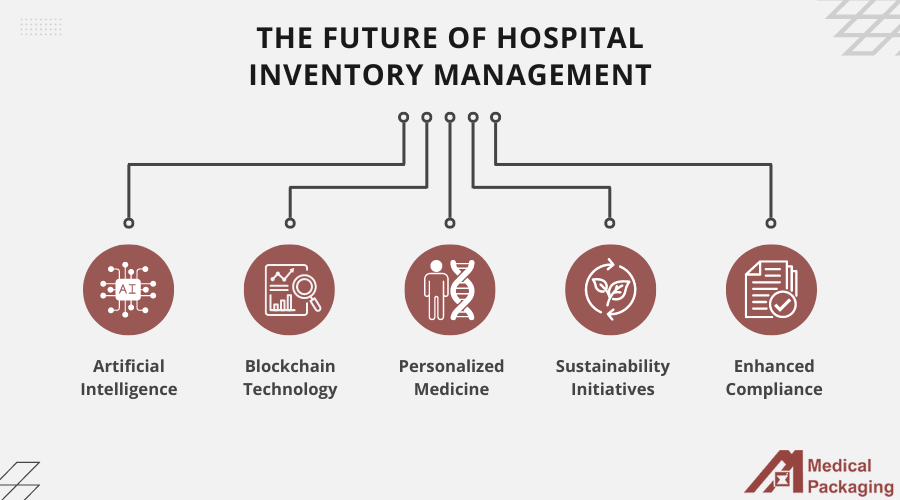Hospital Inventory Management Best Practices
Hospital inventory management is an essential part of improving patient safety and patient outcomes while also reducing inventory costs. Challenges to the health care industry, such as supply shortages and human error, make health care inventory management important. Following best inventory management practices can help hospital administrators achieve better inventory control while remaining in compliance with regulations and handling difficulties within the industry.
Benefits of Inventory Management for Healthcare Organizations
From medical equipment to pharmaceuticals, hospitals are responsible for keeping an inventory count of each item. Doing so helps ensure quality patient care and prevents a health care facility from having too much or too little in stock at any given time. The following are some of the challenges that the health care sector faces, resulting in a greater need for an inventory management system.
Avoid Supply Chain Issues
The hospital supply chain has been experiencing disruptions in recent years. This puts hospitals and other medical facilities at risk of having inadequate medical supplies, which can lead to reduced patient safety and poor outcomes. For example, drug shortages can make it difficult to provide patients with the treatment they need promptly.
Accurate Budgeting
Each hospital and medical facility operates within a budget for medical instruments, medications, and other medical inventory. Without effective inventory management techniques, these facilities can end up ordering too much inventory, which then goes to waste. Having better inventory control increases cost savings for hospitals and other facilities that previously went over budget and wasted medical supplies.
Patient Safety
Having medications and other medical supplies that are past their expiration date can put patients at risk of receiving medication or treatment that has lost its efficacy. Keeping inventory that has been recalled, such as pharmaceuticals, can be dangerous to patients. Each hospital and medical facility should use best practices for inventory management to protect patients from these risks.
Staff Shortages and Improving Efficiency
Staff shortages in a hospital can lead to patient safety issues, such as treatment delays or medication distribution errors. Hospital inventory management helps improve hospital staff efficiency, even when a staff member or medical personnel shortage occurs. This helps keep patients safe from errors while also ensuring that patients receive timely, high-quality care.
Decrease Human Error in Manual Processes
Relying on manual processes for inventory management can lead to human error. Medical personnel might enter the wrong inventory count for some items or fail to update inventory levels for other items. Failure to follow best practices can lead to inadequate medical supplies or other inventory problems.
Compliance
Health care providers at hospitals and other medical facilities must follow federal regulations and other regulations in the healthcare industry, such as the following:
Having an inventory management system in place can make it much easier for these facilities to always remain in compliance.
Best Practices for Hospital Inventory Management
1. Adopt an Inventory Organization Plan
A key practice for managing inventory is keeping it well-organized. A cluttered or disorganized supply space can make it more difficult to have inventory accurately updated. Items can be misplaced, a shortage of items might go unnoticed, or an item can be ordered too much when inventory is organized inefficiently. Choose an organizational plan and stick to it.
Utilize the FIFO (First In, First Out) and FEFO (First Expired, First Out) principles for inventory management:
- FIFO: Ensure older inventory items are used or sold first to prevent expiration or obsolescence.
- FEFO: Prioritize inventory items based on expiration dates to minimize waste and comply with regulatory requirements, especially for pharmaceuticals and perishable items.

You could also consider ABC analysis to categorize inventory based on value and frequency of use:
- Category A: High-value items that are used frequently.
- Category B: Moderate-value items with moderate usage.
- Category C: Low-value items with low usage.
2. Assign Clear Team Responsibilities
Hospitals and other medical facilities have several staff members who are part of inventory management. A few may be responsible for going over purchase orders, while others might be expected to place supply orders. Other team members who might be involved with inventory include medical staff who clean and organize supply rooms and other areas. Hospital administrators should assign inventory management roles and ensure that each team member understands their responsibilities clearly. Conduct training sessions to make sure that these responsibilities are conducted efficiently.
3. Utilize Advanced Technology
Explore advanced technologies like RFID (Radio Frequency Identification), barcodes, and AI (Artificial Intelligence) for real-time visibility, automated data collection, and predictive analytics. These technologies improve accuracy, efficiency, and visibility across the supply chain, enabling proactive inventory management decisions.
Asset tags and barcodes allow for easy and convenient check-in and check-out processes for medical instruments and equipment. This helps lower the risk of misplaced instruments and equipment. Using asset tags and barcodes can also help hospitals and health care facilities reduce operational costs.
The use of barcodes and asset tags is an important part of compliance as well. Having a serial number and lot number on each pharmaceutical, for example, helps hospitals and other facilities meet DSCSA compliance standards for tracking.
4. Forecast Demand with Data
Gathering and optimizing supply chain data and product usage patterns can help hospitals and other medical facilities accurately track inventory and prepare for potential shortages or other disruptions that affect supplies. For example, hospitals might increase purchase orders for supplies that are expected to experience shortages in the near future.
Collecting data and optimizing it should involve reducing the reliance on manual processes that can increase the risk of errors. Hospital administrators should also keep track of lifecycle management and equipment maintenance to plan as equipment nears the end of its lifecycle.
Implementation Considerations for Hospital Supply Management Systems
Cloud Supply Chain Management
A cloud-based health care supply chain strategy can help hospitals and other medical facilities prevent shortages of medication, medical supplies, and medical equipment. Using a cloud-based strategy helps keep inventory information secure and updated in real-time.
PAR vs. Perpetual Inventory
Periodic automatic replenishment (PAR) and perpetual inventory are two different approaches to inventory management. PAR involves updating inventory data at regular intervals, such as every week. Perpetual inventory involves using inventory management software to update data in real-time rather than periodically. PAR can be effective for managing inventory, however it leaves room for error, making it less efficient for larger hospitals and health care facilities. Perpetual inventory often costs more to implement, but it can lead to better accuracy, especially for larger medical facilities.
When choosing a hospital inventory management software to implement best practices, hospital administrators should look for the following qualities:
The Future of Hospital Inventory Management
As health care evolves, so does the management of hospital inventories. Emerging technologies and innovative practices are reshaping how hospitals manage their supplies and ensure patient care remains efficient and effective. Here are the key trends shaping the future of the hospital inventory management process:
- Artificial Intelligence (AI) and Machine Learning (ML): Predictive analytics ensure optimal inventory levels, reducing manual errors and enhancing operational efficiency.
- Blockchain Technology: Ensures transparent supply chain traceability and compliance with stringent regulatory standards.
- Sustainability and Efficiency Initiatives: Implementing eco-friendly solutions to reduce waste.
- Enhanced Regulatory Compliance: Automation of compliance tasks and robust audit trails ensure adherence to health care regulations.
- Personalized Medicine and Inventory Management: Tailoring inventory practices to individual patient needs based on data-driven insights, optimizing patient care pathways.
How MPI Improves Hospital Inventory Management
Medical Packaging Inc., LLC (MPI) offers packaging solutions that can help hospitals and other medical facilities manage inventory more accurately and efficiently while remaining compliant. These solutions can be customized to fit your facility’s needs and requirements.
Our solutions provide hospital inventory managers with the ease of ordering everything from one place. These systems, materials, and benefits include:
- Pak-Edge UD Barcode Labeling Software is the key to enhanced tracking and security. Our new Pak-Edge Version 2.0 takes networking capabilities to the next level with advanced barcoding capabilities and configurations.
- Oral solid and liquid packaging systems offer custom packaging for unit dose oral solids and liquids. These systems are easy to use and cost-effective for a variety of health care markets.
- Overwrapping systems, equipment, and materials are designed for a variety of medications, ampoules, vials, syringes, and more.
- Medical packaging materials are designed exclusively for our packaging systems, so you are relying on one source for all your medication packaging needs.
- Labeling solutions for customers in a wide range of care settings
- MPI provides the best, high-quality customer assurance and technical support.
Our health care systems and related materials are designed with efficiency and safety in mind, promoting all the best practices within your hospital inventory management system.
For more information on MPI solutions to help your hospital or health care facility implement best practices for inventory management, please contact us.
Resources
Center for Devices and Radiological Health. “Radio Frequency Identification RFID.” U.S. Food and Drug Administration, FDA, www.fda.gov/radiation-emitting-products/electromagnetic-compatibility-emc/radio-frequency-identification-rfid. Accessed 10 June 2024.
Ahrmm. “Perpetual vs. Par Inventory.” AHRMM, www.ahrmm.org/perpetual-vs-par-inventory. Accessed 12 June 2024.
Badr, Yara, et al. “The Use of Big Data in Personalized Healthcare to Reduce Inventory Waste and Optimize Patient Treatment.” Journal of Personalized Medicine, U.S. National Library of Medicine, 3 Apr. 2024, www.ncbi.nlm.nih.gov/pmc/articles/PMC11051308/.
Contact MPI Today for Personal Assistance
MPI’s Drug Master File provides speed-to-market regulatory and technical support related to our packaging components for medical and pharmaceutical market clients

